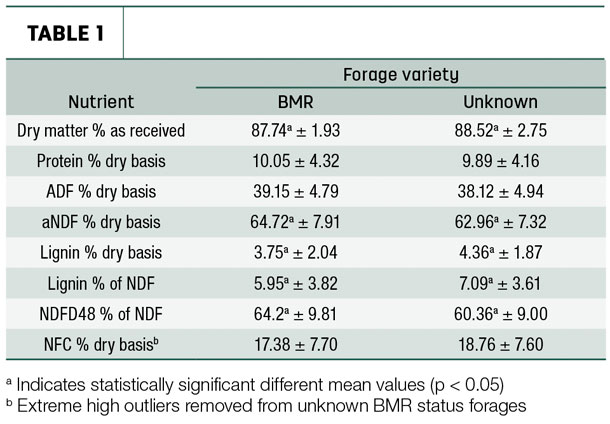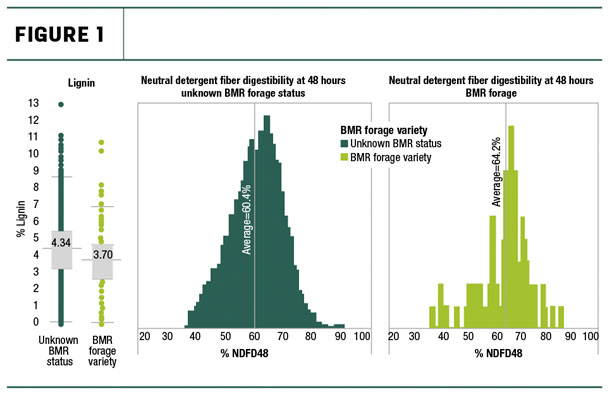Brown midrib (BMR) or low-lignin varieties of sorghum, sudan, millet and hybrid crosses have been commercially available since the 1990s. However, I still receive questions (and opinions) from livestock producers regarding claims that BMR varieties improve animal performance relative to their non-BMR counterparts. Some buy in wholeheartedly, attesting to improved intake and body condition; others say they have not seen the benefits.
To examine these differences, I have pulled together a set of over 2,000 hay samples submitted to our laboratory from Nebraska and surrounding states. The species included are sorghums, millets, sudans, and sudex hybrid crosses. Because this data comes from a commercial laboratory, and we only have the information producers provide us, we are comparing BMR varieties to samples submitted with unknown BMR status. There are BMR varieties in the unknown population, and our findings are more subtle than if we compared them to non-BMR varieties. Table 1 summarizes nutritional values of the samples measured with NIRS Forage and Feed Testing Consortium calibrations.

First, when evaluating BMR and unknown BMR-status forage varieties, there was no difference in the variance. Regardless of lignin genetics, nutrient values and forage quality are variable and range from high quality to low quality within both groups.
Second, protein, acid detergent fiber (ADF) and non-fiber carbohydrate (NFC) averages were not statistically significant between the two groups. This is important because it means lignin does not affect these nutrients and their implication on animal performance. No difference regarding ADF content is important to remember when examining total digestible nutrient (TDN) values. If a low-lignin variety was fed, TDN based on ADF may underestimate animal performance. Conversely, if a higher-lignin forage were fed, the TDN may overestimate performance based only on a small ADF value. A summative TDN equation that considers other nutritional factors impacted by low-lignin genetics would be a more accurate reflection of the energy content of forages. Furthermore, seeing no difference in NFC means any resulting improvements in production performance are not simply due to differences in readily available carbohydrates but rather can be attributed to other characteristics of the forage.
Finally, between the BMR forages and unknown BMR-status forages we observed statistically significant differences in the average values for amylase-treated neutral detergent fiber (aNDF), lignin as a percent of the whole sample and as a percent of aNDF, and neutral detergent fiber digestibility at 48 hours (NDFD48) (Figure 1). Surprisingly, the aNDF average in BMR varieties was nearly 2% higher than the unknown samples. However, the lignin component of the forage, both as a whole and as a portion of the aNDF, is on average lower in BMR varieties. Lower lignin as a portion of the aNDF indicates the BMR varieties should be more digestible and have a quicker rumen passage rate than the unknown forage samples. The NDFD48 average is close to 4% higher in BMR varieties than those with an unknown BMR status, confirming this theory.

So, Figure 1 shows that BMR varieties available to producers are on average lower in lignin and have a higher NDFD48. However, both BMR and unknown varieties span a similar range of values. This implies that regardless of forage variety, producers should analyze their forages and take note of these reported values. While rations and supplementation plans are not based on lignin or NDFD48, the latter is incorporated into summative TDN equations. Thereby, a summative TDN can improve the accuracy and precision of a ration or supplementation plan.
Additionally, researchers evaluating production performance and fiber digestibility have found that increasing digestibility of fibers can significantly increase animal intake. Understanding that for each unit increase of NDFD48, the animal is likely to consume approximately another 1/3 pound of dry matter, which can also impact nutrition formulation plans.
Forages with high fiber digestibility will positively impact a producer’s bottom line. Increases in fiber digestibility result in faster rumen passage rates, which are correlated with increased dry matter intake (DMI). Increased intake results in increasing pounds of energy consumed. Animals receiving more energy from forage consumption require fewer expensive grains or formulated supplements. Moreover, the increased energy available to the animal from improved fiber digestibility results in improved body condition and increased milk yield. With fewer feed supplements required and improved production performance, producers should reap economic benefits from highly digestible fiber forages.
In conclusion, averages comparing BMR varieties to unknown varieties show BMR varieties do have lower lignin and improved digestibility overall. However, both BMR and unknown BMR-status forage varieties have the potential to be high and low in lignin as well as NDFD48. This variation means livestock producers should analyze forages prior to feeding and adjust rations and diets accordingly to derive the monetary gains of low-lignin forage traits. BMR varieties stand up to their claims; however, all forages are the product of their genetics and production management.










